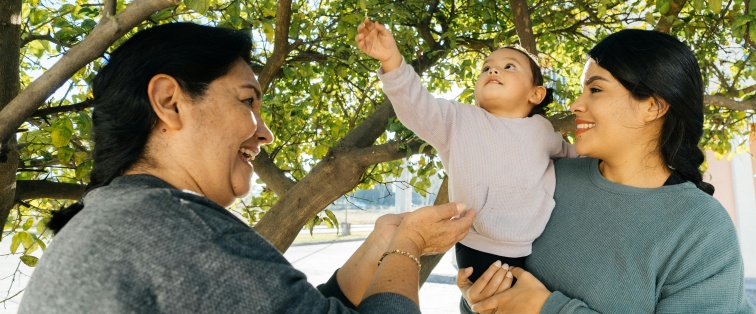Caring for Caregivers: Shining a Light on Mental Health in Early Parenthood


Over the last 15 years, awareness around postpartum depression (PPD) has continued to grow. To that end, in 2010 and 2015, the American Academy of Pediatrics (AAP) and the American College of Obstetricians and Gynecologists (ACOG), respectively, began formally recommending routine PPD screenings. In 2022, following this recommendation, a national sample found 12.7% of mothers with live births reported depression symptoms. Here in Philadelphia, 16% of mothers reported experiencing postpartum depressive symptoms.
While screening recommendations were an important first step to better understand the scale of the critical issue of postpartum depression, they do not go beyond the postpartum period (the first 6-8 weeks following childbirth) and we know little about the mental health of caregivers of young children as they continue moving through early parenthood.
With the high rates of PPD in mind and as researchers exploring caregiver mental health, we were curious about the landscape among mothers and other caregivers of young children—what was happening beyond the postpartum period? In this post, we’ll describe what we uncovered in a research project that follows the health of children and their caregivers over a 5-year period.
Challenges faced by caregivers of young children
Being a parent of young children can be very joyful and fun. Yet this phase can also present additional stressors and challenges. For example, research shows that financial stress experienced by parents negatively affects their mental health and parenting capabilities. These risks may increase for growing families as research indicates that parents also face additional stressors when raising multiple children in early childhood, including the associated mental labor and time demands. Additionally, parents of young children experience barriers to accessing and continuing medical treatment and mental health care, such as a lack of affordability, flexibility with appointments, effectiveness of therapy, and engagement techniques used in therapy.
A snapshot of caregiver mental health in early parenthood
With this backdrop, our team’s Prenatal to Preschool (P2P) study evaluated various outcomes for a cohort of mothers, their children, and secondary caregivers through online anonymous surveys from a child’s birth to age 5. Secondary caregivers include another parent, grandparent, aunt, uncle, friend, etc. As part of this longitudinal study, we chose to highlight the mental health of caregivers of children who are 2-years-old, as the early years of child development are fundamental and can be impacted greatly by household dynamics and caregiver mental health.
To understand household dynamics, we looked at five variables: race, annual household income, relationship to the child, number of adults in the home, and the number of children in the home. Further exploration included whether mothers and secondary caregivers wanted to seek mental health care services and, of those interested in mental health services, how many were actually able to access them.
These findings, which contribute to a larger ongoing study, indicated mild to severe depression symptoms, higher than the rates found during the postpartum period nationally. And, when there was more than one child in the home, secondary caregivers reported experiencing worsening depressive symptoms. We also assessed mothers’ beliefs and perceptions of how their children express emotions and found that mothers reported having more negative beliefs and perceptions when there was more than one child in the home.
Additionally, mothers in this study who reported a household yearly income above $57,000 (the median income for Philadelphia in 2022) reported fewer depression symptoms. Taken into account with previous research demonstrating that those with greater financial stress experience worsening mental health symptoms, these findings suggest that more financial stability can help improve depression symptoms and outcomes.
Finally, mothers and caregivers who wanted to seek mental health care services reported more severe depression scores—yet only half of those who reported wanting mental health services were able to obtain them.
How can we better support the mental health of caregivers at every stage?
Our research adds to the body of evidence around parental depression, showing that the proportion of mothers and secondary caregivers of 2-year-old children in Philadelphia experiencing depression is comparable to—and in some cases higher than—the proportion of mothers in the postpartum period. We’ve also identified that income level is associated with depressive symptoms. Additionally, we’ve confirmed that there are challenges in accessing mental health care. Our research will continue to examine mental health and household dynamics for the families in our cohorts until a child’s 5th birthday.
These findings highlight the need and opportunity to better support young parents throughout the early childhood period. Given that families of young children visit pediatric primary care offices often for well and sick visits, there’s opportunity to test and evaluate recommended universal screening for caregiver mental health. PolicyLab work identifies payment policy that may support these practices. There’s also opportunity to leverage the growing focus on and resources for perinatal mental health, and to ensure that we’re discussing and finding ways to support caregiver mental health in early childhood as well.
More broadly, we also see great value in investing in a caregiving agenda to support young families. As our colleagues identified, policies that support family financial security, access to affordable, high-quality child care, paid leave, and integrated behavioral health care in primary care, would all serve to support family well-being, including the mental health of mothers and caregivers.
